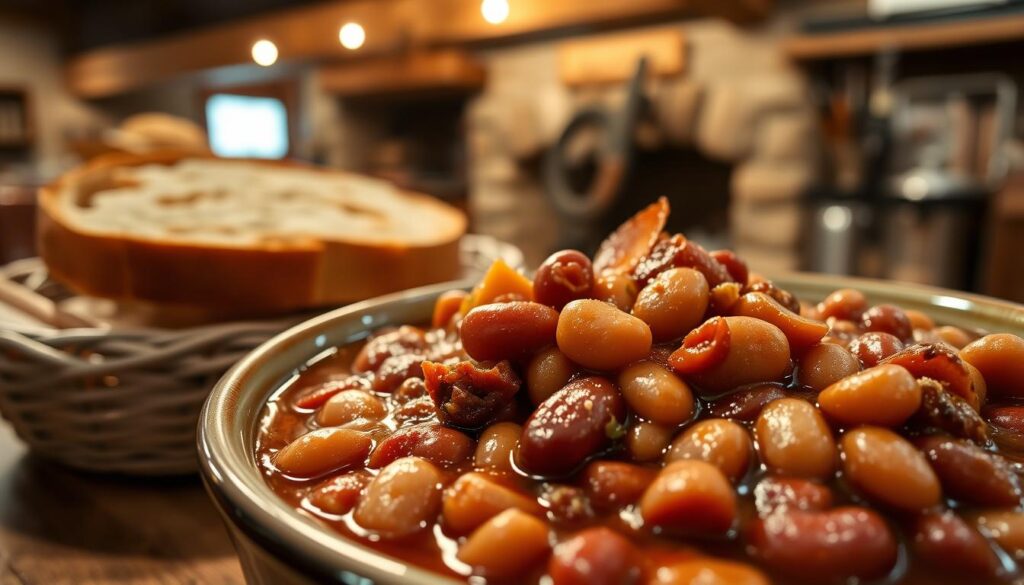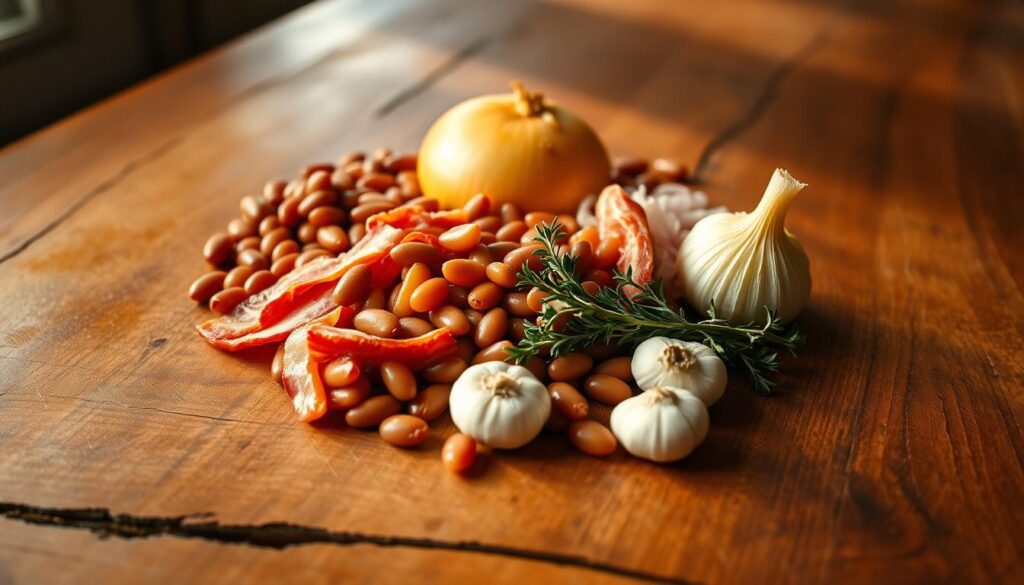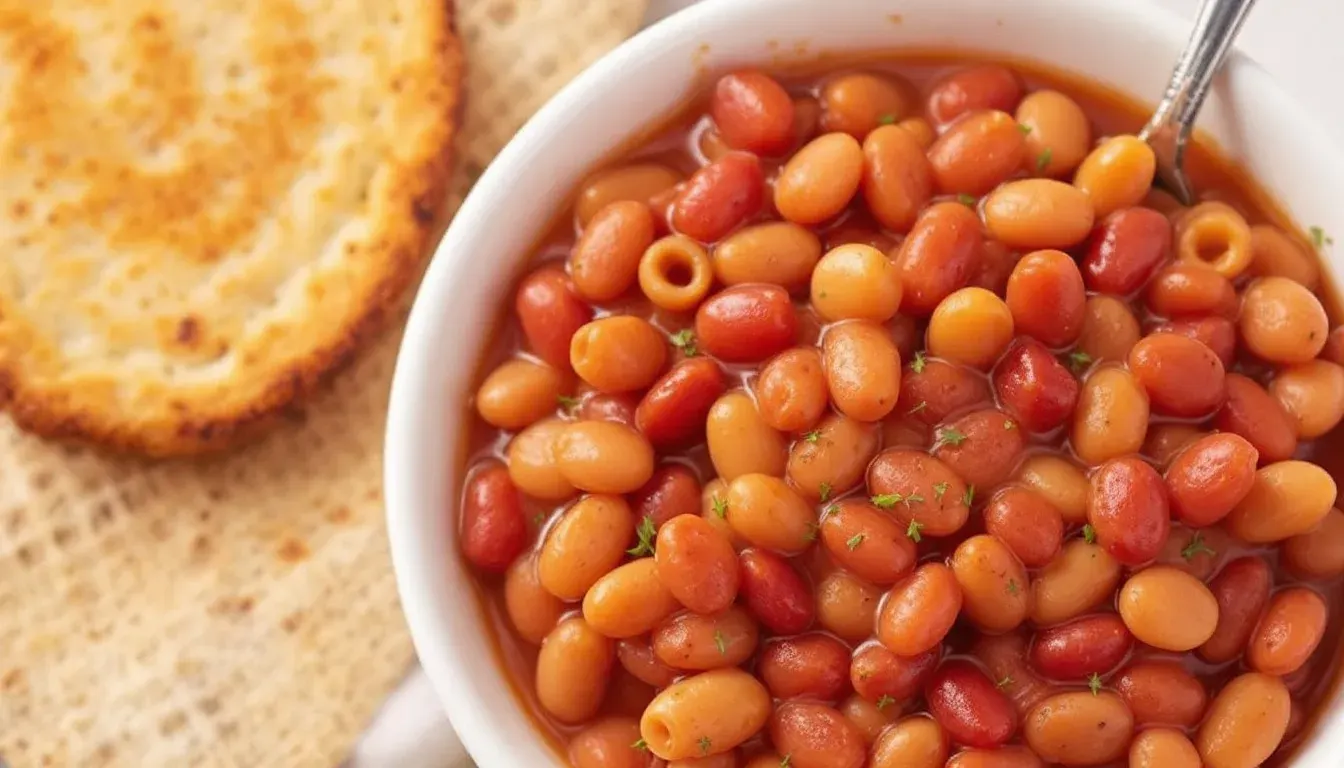
Growing up in Massachusetts, I remember the smell of Boston baked beans in our kitchen every Sunday. My grandmother would slow-cook these beans overnight. She turned simple ingredients into a masterpiece that showed off New England cuisine.
Boston baked beans are more than a side dish. They’re a piece of culinary history. These small white beans, simmered with molasses and salt pork, carry generations of tradition and flavor. Each spoonful shares a story of resourcefulness, immigrant heritage, and the Northeast’s vibrant food culture.
The beauty of Boston baked beans is in their simplicity. Navy beans, transformed by slow cooking, create a dish that’s both sweet and savory. Whether at a family gathering or a local restaurant, these beans connect us to a long-standing gastronomic tradition that has shaped New England cuisine for centuries.
Table of Contents
Key Takeaways
- Boston baked beans are a quintessential New England dish
- Traditional recipe includes navy beans, molasses, and salt pork
- Slow cooking is essential for developing deep, complex flavors
- Nutritious and hearty, with significant cultural significance
- Represents generations of culinary innovation in Massachusetts
The Historical Origins of Boston’s Signature Dish

Boston Baked Beans have a long history in New England cuisine. They come from a mix of cultures that shaped early American food. This dish is a key part of New England’s culinary heritage.
Native American Bean Cultivation
Before Europeans came, Native American tribes grew beans as a main food. They had advanced farming skills. These skills helped start New England’s food traditions.
- Native Americans developed intricate bean-growing methods
- Beans were crucial for nutritional survival
- Multiple bean varieties were cultivated across different tribes
Colonial American Influences
European settlers took up Native American bean farming. Beans were cheap and versatile, becoming a staple in colonial diets. They learned to cook beans slowly to make them taste better and be more nutritious.
The Role of Maritime Trade
Maritime trade was key in changing bean dishes. Trade with the Caribbean and West Africa brought molasses. This sweetener is a key flavor in Boston Baked Beans.
Knowing these roots helps us see how Boston Baked Beans grew. They went from a basic food to a beloved dish that still shapes New England’s food scene.
Understanding Boston Baked Beans: Traditional Ingredients

Navy bean dishes have deep roots in New England’s culinary tradition. The foundation of authentic Boston baked beans starts with small white navy beans. These beans are chosen for their creamy texture and ability to soak up rich flavors.
The key to exceptional molasses beans lies in selecting premium ingredients. Traditional recipes call for specific components that create the dish’s distinctive taste:
- Navy beans – the primary ingredient
- Salt pork or thick-cut bacon for depth of flavor
- Molasses – a crucial sweetening agent
- Brown sugar for additional sweetness
- Dry mustard for subtle spice
Local cooks understand that proper preparation is an art form. The beans require patient slow-cooking, typically simmering for up to 16 hours. This extended cooking time allows the ingredients to meld together, creating a rich, complex flavor profile.
While traditional recipes remain consistent, modern variations have emerged. Some chefs experiment with alternative sweeteners like maple syrup or introduce regional spices. Despite these adaptations, the core ingredients remain true to the original New England recipe that has delighted generations of food lovers.
Your journey into navy bean dishes becomes a culinary exploration of history and flavor. Each ingredient plays a crucial role in transforming simple molasses beans into a beloved regional specialty. It continues to warm hearts and satisfy appetites across New England.
The Molasses Connection: Why It’s Essential
Molasses is more than just a sweetener in Boston baked beans. It’s the heart and soul of the dish. This dark syrup has been key in New England cuisine. It turns simple molasses beans into a masterpiece that tells a story of trade, culture, and flavor.
The story of molasses in Boston baked beans starts with the triangular trade. Ships from New England went to the Caribbean, bringing back molasses. This sweet syrup became a staple in local kitchens, defining traditional maple syrup baked beans.
The Triangular Trade’s Culinary Legacy
Molasses brought more than sweetness to Boston’s tables in the colonial era. It was part of a complex economic and cultural exchange. The unique flavor of molasses beans shows New England’s maritime heritage.
- Molasses provided a deep, rich sweetness
- It was more affordable than refined sugar
- The syrup added complexity to traditional bean recipes
Sweetening Methods Through History
Home cooks found molasses did more than sweeten baked beans. It created a caramelized flavor that’s a hallmark of New England cooking. Molasses offered a depth that transformed simple ingredients into a memorable dish.
Modern Molasses Alternatives
Today, you can choose from more than traditional molasses. Maple syrup baked beans are a popular alternative. Each sweetener adds its own character to the dish, allowing for creative takes on this beloved New England staple.
Nutritional Profile and Health Benefits
Explore the world of baked bean recipes and discover navy beans’ nutritional power. One cup of Boston baked beans is a nutritional powerhouse. It supports your health and wellness.
Navy beans are a nutritional goldmine, offering essential nutrients. Let’s look at the key nutrients:
- Calories: Approximately 300 per cup
- Protein: 12 grams
- Carbohydrates: 54 grams
- Fat: Less than 1 gram
Navy bean dishes are not only delicious but also great for your health. They are high in fiber, which supports digestive health and helps control blood sugar. Iron and potassium in these beans are good for your heart and energy.
| Nutrient | Amount per Cup | Health Benefit |
|---|---|---|
| Fiber | 15 grams | Supports digestive health |
| Iron | 4.5 mg | Supports oxygen transport |
| Potassium | 750 mg | Regulates blood pressure |
While baked bean recipes include molasses, which adds sugar, navy beans’ benefits outweigh this. Moderation is key when enjoying these dishes.
Studies show that eating beans regularly can lower cholesterol and help with weight management. By adding navy bean dishes to your diet, you choose a nutritious and satisfying meal.
Boston Baked Beans: The Classic Recipe
Unlocking the secrets of authentic Boston baked beans takes passion, patience, and the right technique. These slow-cooked beans are a big part of New England’s food history. Whether you’re a home cook or a foodie, mastering this recipe will boost your cooking skills.
Essential Cooking Equipment
Preparing slow-cooked beans needs specific kitchen tools for the perfect texture and flavor. Here’s what you’ll need:
- Large ceramic bean pot or Dutch oven
- Heavy-bottomed baking dish
- Large mixing bowl
- Measuring cups and spoons
- Wooden spoon
Ingredients and Preparation
The secret to great Boston baked beans is using high-quality ingredients and a precise method. Let’s look at the key components:
| Ingredient | Quantity |
|---|---|
| Dried navy beans | 1 pound |
| Salt pork or bacon | 1/2 pound, diced |
| Molasses | 1/3 cup |
| Dark brown sugar | 1/4 cup |
| Dry mustard | 1 tablespoon |
Step-by-Step Preparation Guide
- Soak beans overnight in cold water
- Drain and rinse beans thoroughly
- Combine beans with salt pork in bean pot
- Mix molasses, brown sugar, and spices
- Pour liquid mixture over beans
- Add water to cover beans completely
- Bake at 300°F for 4-5 hours
Tips for Perfect Results
To get the best Boston baked beans, pay attention to detail. Check the beans often and add water if they seem dry. Stir gently to avoid sticking. The beans should look rich and have a deep mahogany color.
Your homemade baked beans will last up to 5 days in the fridge. This lets you enjoy this classic New England dish all week.
Regional Variations and Modern Adaptations
Boston baked beans have grown beyond their old ways. They now show off different tastes across the country. New England’s food scene keeps making this classic dish new again, with recipes that respect its history and fit today’s tastes.
Each New England state has its own twist on baked beans:
- Maine: Uses native bean varieties with a deeper molasses profile
- Massachusetts: Emphasizes traditional small white navy beans
- Vermont: Incorporates local maple syrup for sweetening
Today’s baked bean recipes meet new dietary needs. Vegetarian and vegan adaptations are very popular. Chefs are trying new things, like different proteins and plant-based ingredients, to make the dish exciting again.
Now, you can find baked beans with a global twist. They mix old Boston baked bean ways with flavors from around the world. This shows how a simple dish can connect cultures while staying true to its roots.
Whether you love the old ways or like to try new things, there’s a baked bean recipe for you. Boston baked beans are loved by all, from the classic to the bold and new.
Serving Suggestions and Traditional Pairings
Boston baked beans are best when paired with the right sides. They can make your meal even better. You can try both traditional and modern ways to serve these tasty bean dishes.
Classic side dishes can turn a simple meal into something amazing. Here are some top pairings:
- Crisp coleslaw
- Tangy potato salad
- Pickled vegetables
- Grilled summer vegetables
Bread Accompaniments
No bean dish is complete without bread. Boston brown bread is the perfect match. It’s dense, slightly sweet, and made with whole wheat flour, rye, and cornmeal. This bread balances the rich, savory beans perfectly.
Modern Serving Ideas
Try these new ways to serve traditional bean dishes:
- Top baked potatoes with warm beans
- Use as a hearty breakfast side
- Incorporate into breakfast burritos
- Create bean-topped bruschetta
Whether it’s a weekend barbecue or a cozy family dinner, these ideas will highlight Boston baked beans. They’re sure to impress.
Conclusion
Boston Baked Beans are more than a side dish. They take you on a journey through American history. This iconic New England dish shows the mix of cultures, from Native American to colonial farming.
These beans share a story of strength, creativity, and community. They still touch the hearts of food lovers in the U.S.
When you make Boston Baked Beans, you join a long tradition. It’s great for BBQs, family dinners, or cozy nights. Each dish connects you to cooks who loved making this recipe.
They turned simple ingredients into a favorite dish. This shows the power of cooking in bringing people together.
As you try new things with Boston Baked Beans, remember cooking is an art. You can follow the old recipe or make your own twist. This keeps the dish’s story alive.
New England cuisine values simplicity, quality, and sharing meals. It’s about enjoying good food with loved ones.
Let Boston Baked Beans guide your cooking. Your kitchen is now a doorway to a tasty part of American history.
FAQ
What makes Boston Baked Beans different from other bean dishes?
Boston Baked Beans stand out because of their sweet and savory taste. They use molasses for sweetness and salt pork for depth. Unlike others, they’re cooked slowly in a bean pot, giving them a unique caramelized texture.
Are Boston Baked Beans healthy?
Boston Baked Beans are nutritious but should be eaten in moderation. They’re packed with protein and fiber from navy beans. They also have minerals like iron and potassium. But, the molasses adds a lot of sugar, so they’re best part of a balanced diet.
Can I make Boston Baked Beans without pork?
Yes, you can make them without pork. Use smoked paprika, liquid smoke, or vegetarian bacon to keep the smoky flavor. This makes them perfect for vegetarians and vegans.
What’s the best way to cook Boston Baked Beans?
Traditionally, they’re cooked in a ceramic bean pot. But, you can also use a slow cooker or Dutch oven. The key is to cook them slowly. This makes the beans tender and rich in flavor.
What should I serve with Boston Baked Beans?
Classic sides include Boston brown bread, coleslaw, potato salad, and hot dogs. They’re also great at barbecues, picnics, or as part of a New England-style breakfast.
How long can I store homemade Boston Baked Beans?
Homemade beans can be stored in an airtight container in the fridge for 4-5 days. You can freeze them for up to 3 months. This makes them a great choice for meal planning.
Can I use maple syrup instead of molasses?
Yes, maple syrup is a tasty alternative to molasses. It adds sweetness and can be a nice twist on the classic recipe.
Are canned Boston Baked Beans authentic?
Canned beans are convenient but not as authentic. Homemade beans have a richer flavor and texture. Canned versions are quicker but lack the depth of slow-cooked beans.
What about this recipe ?
There are no reviews yet. Be the first one to write one.








1 thought on “Boston Baked Beans: The Hearty, Flavorful New England Staple”
Comments are closed.